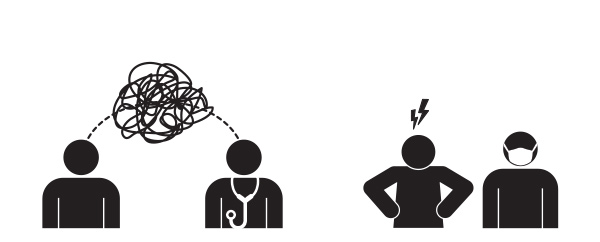![]() More than ever before, provider referral networks are becoming larger and more impersonal; ultimately leading to care fragmentation for both patients and providers.
More than ever before, provider referral networks are becoming larger and more impersonal; ultimately leading to care fragmentation for both patients and providers.
This is important to realize as it has serious ramifications for the quality and costs of health care moving forward. For example, a few of the direct results of poor care coordination include:
- Critical patient information going missing during referrals or transitions
- Safety net providers dealing with vulnerable populations with no specialty care or support
- Support services being underutilized or not utilized at all
These are just some of the general consequences that we see associated with care fragmentation. We’ll go into more of the specifics later.
The solution is to enable high-quality referral management and transitional care coordination. But first, we must understand what causes care fragmentation to occur in the first place.
How Does Care Fragmentation Happen? (Source)
Care fragmentation is a direct result of health inequalities, unsustainable and increasing healthcare costs, and a lack of quality care.
Healthcare in this country suffers from the Three I’s. It is Inefficient, Ineffective, and Inequal. Let’s take a look at each of these in more detail:
Inefficient
![]() Healthcare in the United States is an extremely inefficient process. Most programs and services offered by providers in this country tend to be too narrowly focused, ultimately leading to inefficient delivery of medical care.
Healthcare in the United States is an extremely inefficient process. Most programs and services offered by providers in this country tend to be too narrowly focused, ultimately leading to inefficient delivery of medical care.
Much of these inefficiencies stem from the costs of healthcare being too high. According to the American Journal of Managed Care, patients of primary care providers with high rates of care fragmentation experienced a greater number of preventable hospitalizations, which equated to an average increase of $4542 in healthcare spending.
To achieve truly efficient health care requires coordination amongst systems and communities.
Ineffective
![]() Similarly, healthcare in this country is ineffective as it is fragmented at its core. Different elements that make up the industry including scientific research, public health initiatives, and philanthropic efforts, are all directed towards separate sectors and programs. Unfortunately, investing more in the parts has not improved the whole. Systemwide and integrative health approaches are being pushed aside in favor of short-term incentives and profit. Providers can only do so much. Until there is a system-wide and organizational emphasis on integrative medical care, healthcare will always largely be ineffective in this country.
Similarly, healthcare in this country is ineffective as it is fragmented at its core. Different elements that make up the industry including scientific research, public health initiatives, and philanthropic efforts, are all directed towards separate sectors and programs. Unfortunately, investing more in the parts has not improved the whole. Systemwide and integrative health approaches are being pushed aside in favor of short-term incentives and profit. Providers can only do so much. Until there is a system-wide and organizational emphasis on integrative medical care, healthcare will always largely be ineffective in this country.
Inequal
![]() The way the healthcare system is set up in this country forces hospitals and healthcare organizations to look to attract a certain patient profile or “case mix.” This is necessary for them to continue operating as it helps to cover their enormous costs, as well as provides them with revenue so that they can stay competitive within their market.
The way the healthcare system is set up in this country forces hospitals and healthcare organizations to look to attract a certain patient profile or “case mix.” This is necessary for them to continue operating as it helps to cover their enormous costs, as well as provides them with revenue so that they can stay competitive within their market.
As the healthcare industry has become more commercialized, care has become a commodity. Patients are customers, and are free to choose their healthcare vendor based on factors such as cost, quality, convenience, access, and others. Indeed, the private financing of the industry has led to rampant overuse of medical services and significant barriers to entry to those less fortunate. And while healthcare has built-in so-called safety nets to ensure that no one goes without care, there are many who fall in between.
As a result, healthcare in this country is inequal. Even though most providers will treat anyone who comes through their door, they are largely ignorant of the overall healthcare barriers that many of the population faces. Population health and social policy are overarching factors that must be taken into account when developing strategies for better care coordination.
Check out our article on population health here.
What Are the Effects of Care Fragmentation? (Source)
Let’s take a look at some of the specific effects of care fragmentation:
-
PCPs not receiving information after a referral
This is one of the most common and direct results with care fragmentation. The primary care physician is a patient’s most trusted resource when it comes to his or her health. Patients see their PCP for most things and are only referred out to specialists if there is some further complication that can’t be addressed by the primary care provider. The problem occurs when a PCP refers their patient to a specialist and then either the specialist or the PCP does not follow up. This happens more often than not, and the lack of communication can lead to bad care and poor health outcomes.
Why does this happen:
-
- Doctors get busy and forget
 Let’s face it; doctors are busy people. We’d like to think that they remember every detail about every single patient that they see, but it’s not realistically feasible. Therefore, it’s understandable that they might forget to follow up on a patient after referring them to a specialist.
Let’s face it; doctors are busy people. We’d like to think that they remember every detail about every single patient that they see, but it’s not realistically feasible. Therefore, it’s understandable that they might forget to follow up on a patient after referring them to a specialist.
However, it’s not all on the referring provider. The specialist shares responsibility for following up with the PCP about a specific patient. But once again, let’s not forget that the specialist is also a doctor and is also busy. It would be nice if there was a convenient method for these providers to easily communicate with each other in real-time, which brings us to the next barrier that leads to poor care coordination.
-
- Don’t have an efficient means to communicate
![]() Health providers spend an inordinate amount of time documenting and recording the process of care, using new technologies and software to increase efficiency and save valuable time. Unfortunately, software that helps to increase communication and engagement amongst providers is still lacking.
Health providers spend an inordinate amount of time documenting and recording the process of care, using new technologies and software to increase efficiency and save valuable time. Unfortunately, software that helps to increase communication and engagement amongst providers is still lacking.
Without an effective platform to easily communicate with their referral network, providers are stuck with a cumbersome process of following up manually (usually by phone or email), which can quickly lead to fatigue on the provider’s part.
-
Not notified about discharges
As noted above, care fragmentation is a direct result of poor communication among providers. This lack of communication inadvertently can lead to further care fragmentation as providers are not notified when their patients are discharged from the hospital.
This is a problem because a provider may think their patient is still in the hospital and may schedule a time to see them, not having known that they had already been discharged or who put the discharge order in. Both the provider and hospital are liable if a patient has been discharged before they are ready to be and if something happens to that patients, both parties could be in serious trouble.
![]()
-
Not involved in any discussions before discharge
Similarly, the provider or PCP should be involved in all discussions before the discharge of a patient. Once again, they are liable for anything that can happen to the patient outside of the hospital. Many medical malpractice suits have started with a patient being discharged too early from the hospital or care center.
A study by the Agency for Healthcare Research and Quality shows that almost 20% of patients experience some sort of adverse effects or events within three weeks of discharge from a hospital. The study also shows that nearly 75% of these events are preventable.

-
PCPs not receiving discharge summaries in a timely manner or with missing information (e.g., pending medical tests, missing Rx, no follow-up plan)
A lot of the problems that arise from discharge errors are due to a lack of timely communication and missing information. This can be solved with better software that can help hospitals communicate with their providers (both in and outside of their network) in real-time. The software should also be able to integrate with the hospital’s EMR so that relevant patient data including medical tests, procedures, prescriptions, and all notes are available to the provider when they are communicating and deciding whether to discharge a patient or not.

-
Diminished health outcomes
Diminished health outcomes are a direct result of care fragmentation. When providers are not notified properly about their patients, then they cannot provide proper care when it is necessary. This leads to poor health outcomes for patients of the hospital and the provider, possibly resulting in penalties from the state and a lack of confidence from future prospective patients.
![]()
-
Redundant work
Care fragmentation also leads to a lot of redundant work on the part of the provider and the patient. Within the care continuum, providers must follow up not only with the patient but also with the other providers and specialists that took part in that patient’s care. This requires hearing the same information from different sources, but it is essential to providing thorough care.
Patients may need to reiterate much of their medical history because of care fragmentation. A lack of communication amongst providers means that when a patient goes to see a specialist or new doctor, that new doctor may not have any prior information about that patient leaving the patient to recall their medical history.
Again, both of these problems are easy to solve with integrated and compatible communication software.

-
Frustration among provider and patient
And of course, care fragmentation ultimately leads to frustration amongst providers and patients alike!

What Is Needed? – Care Coordination!
Care coordination is needed! There must be the planned integration of patient care actions between two or more providers to achieve the appropriate delivery of health care services.
- What are some of the positive benefits of care coordination:
- Reduce fragmentation
- Improve the quality of referrals and care transitions
- Contribution to National Committee for Quality Assurance (NCQA) “must pass” element for Patient-Centered Medical Homes (PCMH)
- Referral tracking to create a leaner workflow and better quality of care
- Patient and provider collaboration and advocacy
- Payer assurance that quality and cost meet clinical requirements
![]()
Our solution is a real-time communication platform among providers and organizations that help streamline the referral process as well as ensures that care coordination is maximized. Learn more about referralMD’s industry-leading software here and experience a better way to manage your specialty care network.












